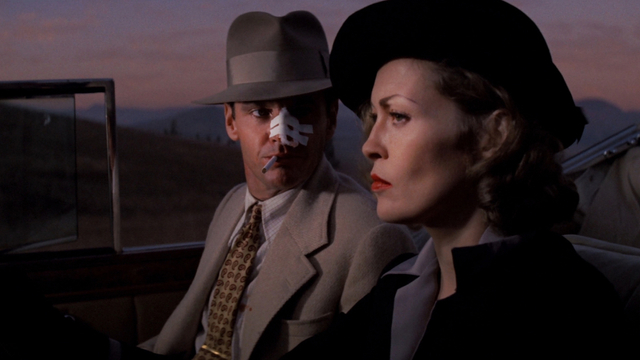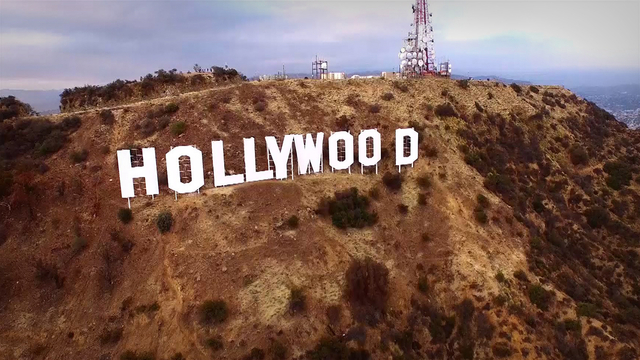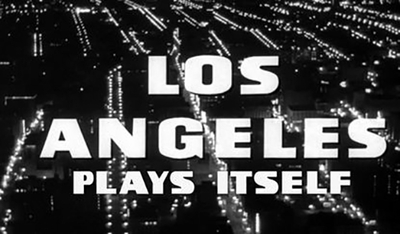Near the beginning of Los Angeles Plays Itself, the narrator states without hesitation that Los Angeles is "the most photographed city on Earth." While you might protest – surely New York might be as likely to fit this description – simple probability and convenience, amplified by the narcissism and self-regard of Hollywood (itself not Los Angeles per se, but an inextricable part of its whole), makes this seem more like a fact.
As discussed later in the film, Los Angeles is also constantly being destroyed onscreen – morally if not physically. Disaster films and apocalyptic thrillers love lingering on the Hollywood sign in flames, the homes of the rich clinging to the sides of the hills cascading into the valleys below, and the whole city splitting along the San Andreas fault and tipping into the surf.
The destruction of Paris, Tokyo, London and New York by invading aliens or errant meteorites are universally understood to be civilizational tragedies; the decimation of Los Angeles' iconic City Hall and the glass towers of the city's unloved downtown are less so, but they happen onscreen with equal if not greater frequency.
While these apocalyptic spectacles are all equally crass, the narrator reflects, with L.A. "it's more often a case of economic expediency than ideology. Hollywood destroys Los Angeles because it's there...it's closer."
Los Angeles Plays Itself is a documentary – a visual essay, more correctly – by film professor and experimental filmmaker Thom Andersen, originally released in 2004. For a decade it could only be seen at special screenings with Anderson present, or through file-sharing networks. (I downloaded it then in admittedly dubious legal circumstances.) It took the efforts of a lawyer who understood fair use provisions in copyright law for Anderson to revise his film for an official Blu-ray release in 2014.
Editing together countless clips from hundreds of films, Andersen tells the story of how the place where movies get made became a background, a setting and then a character in films. At the same time the city was transforming itself from its original identity – "a resort, not a city" – into one of the most unique urban entities in the world, although the shared image of Los Angeles is more a constantly variable mix of fantasy, myth, PR and iconography than the place where over 12 million people live, only one in twenty of whom work in or around the entertainment industry.
It's an intensely personal film that began with his negative reaction to the 1997 film L.A. Confidential, loaded with subjective takes on the subject that verge on polemic. Andersen has strong opinions about how his city is treated in films. (He was actually born in Chicago, but since so few Angelenos at any time were born in the city, claims on the place as a hometown are made according to criteria over which no legislating body has oversight.) His strong opinions are keenly expressed – here are a few things that Andersen hates: '70s interior design; writer Joan Didion; the Hollywood Walk of Fame; geographic license; director Henry Jaglom; people who call it "L.A."; the blacklist; film critic David Thomson.
Andersen spends a good deal of the film showing how Hollywood's use of Los Angeles tends to default to stories about corruption and scandal. This began near the end of the Depression, when the movie industry finally developed a sense of the city as a real place, and found its expression in film noir, co-opting the voices of writers like Raymond Chandler and James M. Cain to tell seedy stories about desperate people and the institutions – the police, the judiciary, city hall, the ruling elite – who seem happy to ignore violence and murder as long as it doesn't get in the way of making money or their personal vices or an ever larger, wealthier, more sprawling metropolis. Even after the death of the noir genre, movies inevitably portray L.A.'s police as bent, violent and adversarial right up to the present day. Andersen takes pains to point out that the LAPD motto – "To Protect and to Serve" – is presented ironically, in quotation marks.

For many moviegoers corruption was baked into the foundational myth of Los Angeles with Roman Polanski's 1974 film Chinatown. Scriptwriter Robert Towne – an actual native-born Angeleno – took the story of founding father William Mulholland's schemes to provide water for the future development of the city and creatively twisted the historical facts. Mulholland became Hollis Mulwray, but Towne transformed him into an opponent of craven water theft from farmers in the valley northwest of the city, disguised as a fake drought, and of the construction of an unsound dam; the writer effectively swapped the real Mulholland for Noah Cross, a fictional character (and Chinatown's indelible villain) played by John Huston. Jack Nicholson's Jake Gittes, a private detective, is always one step behind Cross, the corrupt establishment and their paid-for police force, and loses to their cynical plans in the end.
Andersen details carefully how the film makes a mess of the real facts, while admitting that for most people its fantasy became fact, an evocative explanation for the rot at the heart of Los Angeles, even for people who live there. "This is history written by the victors," says the narrator, "but it is written in crocodile tears. The truth was always out there." What movies paint as conspiracies are a matter of public record, and the real scandals make the ones in movies pale by comparison.
Hollywood is pretty hard on Los Angeles, but forced to justify the scorn they could simply aver that they're pretty hard on themselves as well. Hollywood has been making films about its darker side for almost as long as they've been filming them under the cloudless skies of Southern California; from George Cukor's What Price Hollywood? to Sunset Boulevard to The Bad and the Beautiful to Valley of the Dolls to Day of the Locust to The Player to Barton Fink to Maps To The Stars and all of the versions of A Star is Born, Hollywood has told the story of its own superficiality, venality, unfettered ego and heartless exploitation of the young, old, beautiful, homely, sane, mad, talented and untalented with an unseemly relish untarnished by shame.

This means that for most people, Los Angeles comes front-loaded with myths, stories, issues and preconceptions that few other places burden you with as either a visitor or a settler. I had lived on these assumptions for four decades before I finally visited the city for the first time, and it took me a long time to see past them; most tourists – there for a bus tour and a visit to Grauman's (now TCL) Chinese Theatre and the Hollywood Sign for an Instagram selfie before heading off to Disneyland – don't have the time or inclination to try.
I reached out to a friend who actually lives in the city for insight. Robert Avrech is a Hollywood screenwriter and blogger, the Brooklyn-born son of a rabbi who moved to Los Angeles four decades ago. Like most of us who grew up in the post-war years, he learned about Los Angeles through television.
I remember watching the Mickey Mouse Show and feeling that the Mouseketeers were children my age, but children who were from, well, another planet. They were beautiful and talented and they seemed never to go to school, but to live their lives in the magical kingdom of Disneyland and the white beaches of Malibu.
Various TV series further molded my image of California as a place where Leave it to Beaver, Ozzie and Harriet, Father Knows Best, Our Miss Brooks, and so many others, presented a narrative that was as far away as planet Mars. Life in California, as I imagined it, consisted of lovely homes with white picket fences, mothers who wore pearls as they dusted, and fathers who were solid, and overflowing with patience and wisdom.
I knew that California was the place where movies were made, thus every street, and every man, woman and child, was beautiful and glamorous.
I loved California with a mad ardor that I barely understood.
And yet California scared me.
Really scared the crap out of me because there were no Jews in that magical kingdom.
All California people – the cast, if you will – were anything but Jewish.
As an Orthodox Jew in Brooklyn I was surrounded by family and community that was devoted to God, the Torah, the love of Israel.
The California narrative that was firmly embedded in my little brain was explicitly free of Judaism.
Were there any Jews in California? I wondered.
Truth is, I was certain that California/Hollywood/Los Angeles was Judenrein.
Of course, as a cineaste and later as a working screenwriter Robert would know that there are Jews in Hollywood, and have been since its beginning. But the image he'd been able to assemble with the material movies and television had given us was as different from reality as Thom Andersen's lived Los Angeles is from the L.A. of the movies he consumes.
In my working class, largely Catholic suburb of Toronto, L.A. was aspirational – beaches and young people with cars and diners with car hops and the Beach Boys and their faintly Episcopalian version of rock and roll. It was definitely more attractive than Canada, and one older brother on my street ran away from home, intent on thumbing his way to Santa Monica or Malibu, only to strand himself in Wyoming in the winter, where he made the panicked call home for help.
Crime shows like Dragnet and The Rockford Files would fill out the myth with prime time-friendly glimpses of the darker side of paradise, stretched further by movies that Andersen mines for his film – a late '60s/early '70s renaissance of L.A. stories as different as The New Centurions, Zabriskie Point, The Long Goodbye, Point Blank, The Outside Man, Gone in Sixty Seconds, Two Minute Warning, Earthquake, A Woman Under The Influence, The Omega Man and The Choirboys. The streets there, we understood, were full of hitmen, weirdos, mutants, basket cases, snipers, car thieves and jaded, trigger-happy cops.
Los Angeles has apparently always been getting worse, even when it was still the city of dreams for anyone seeking stardom or escaping winter. "Although Los Angeles is a city with no history," states the narrator, "nostalgia has always been the dominant note in its image of itself." In short, the city was indeed paradise, albeit only at any random point in its past.
When did the rot set in? Andersen's film suggests any number of points, from the dismantling of the streetcar network and the defeat of public transit bills for decades to the zoot suit riots. But the place most mourned in the film is Bunker Hill, a neighbourhood of Victorian homes that was once a favorite film location, a neighbourhood that could suggest quaintness or squalor, and whose iconic landmark was the Angels Flight, a funicular railway appearing in TV and movies from 1918's Good Night, Nurse! starring Buster Keaton and Fatty Arbuckle, through The Night Has A Thousand Eyes, Criss Cross, Joseph Losey's 1951 remake of Fritz Lang's M, The Glenn Miller Story, Kiss Me Deadly, episodes of Dragnet and Perry Mason and all the way to La La Land.
Bunker Hill was cleared for urban redevelopment in the late '60s, and the Angels Flight was dismantled and put in storage for 27 years before being reconstructed half a block south of its original site. By then, as the narrator tells us, it no longer served as a link between anything in particular, as the whole of Bunker Hill had been replaced by undistinguished urban plazas and office towers. Andersen describes the new Bunker Hill as "a simulated city," but it reminds me of much of downtown Toronto, an urban anyplace that could stand in for anywhere.
But nobody is going to make a documentary about Toronto in the movies, no matter how many films are shot here; Los Angeles might not have history, but it has mystique and mythology, and that counts for a lot.
Andersen points out that the Los Angeles movie of the '80s – Blade Runner – is a sci-fi movie that only uses two actual locations in the city: Frank Lloyd Wright's "Mayan Revival" Ennis House and the Bradbury Building, an 1893 office building in the old downtown, with its signature exposed elevators, wrought iron railings and skylit atrium. It was so well-used that the film's art director had misgivings about using it, but director Ridley Scott just told him to wait and see what he'd do with it.
Blade Runner's Los Angeles is described as a dystopia, though the narration points out that the city we see Harrison Ford's Dekker navigate is "a city planner's dream come true. Finally a vibrant street life. A downtown crowded with night-time strollers. Neon beyond our wildest dreamers. Only a Unabomber could find this totally repellent." I certainly remember that I wasn't the only person who saw it in the theatres who actually wanted to live in that city.

But Blade Runner was set in the Los Angeles of 2019; it's become probably the greatest example of nostalgia for a future that never happened, and now the city can dream of an utterly imaginary point in time when it was better. The L.A. of today has become nobody's paradise except for those lucky enough to have one of those houses in the hills or on the beach; high taxes, extreme regulation and the natural evolution of the corruption that was always assumed in city and state politics has made it a place people are leaving.
Los Angeles Plays Itself is over three hours long, and comes with a helpful intermission if you feel overwhelmed by everything Andersen packs into its epic runtime. For all the effort Andersen put into assembling his cinematic essay, it's hard to escape the dismay, disappointment and even dislike he has for many of the films he quotes onscreen (starting with L.A. Confidential.) He does, however, celebrate a small group of obscure films he considers the product of the "walker's Los Angeles" – the city seen on foot.
There's The Exiles, a 1961 neorealist, neo-documentary set in the Bunker Hill neighbourhood that follows around a group of Native Americans who left their reservations to live in the city. It was never released theatrically and only rediscovered twenty years ago, when it provided Andersen with valuable footage of a long-gone city that hadn't been filmed by Hollywood.
And then there's a more recent collection of films by and about African-Americans – Haile Gerima's Bush Mama (1979), Charles Burnett's Killer of Sheep (1978) and Billy Woodberry's Bless Their Little Hearts (1983). They're all pretty grim documents of life lived by L.A.'s poor and underclass, and even they can't avoid that sense of nostalgia.
In Bless Their Little Hearts, the family's unemployed father takes a drive past what the narrator describes as "a reverse landmark, one of the closed industrial plants that had once provided jobs for the black working class of Los Angeles. Built in 1919 and closed in 1980, the Goodyear factory on south Central Avenue was the first and largest of the four major tire manufacturing plants once located in the Los Angeles area."
It makes sense that L.A., a city of cars, would have four tire plants to service its needs, and it's not surprising that it was driven offshore – like the suburbs in Blade Runner that relocated off-world. Of course the rust belt has an outpost in the city of sunshine, leaving behind the movie business that was always just a service industry, selling us a luxury good that we've deemed essential. "Once upon a time, visitors could take a guided tour and see how tires were made," the narrator says, "just as today they can take a studio tour and see how movies are made."
Mark Steyn Club members can let Rick know what they think by logging in and sharing in the comments below, as access to the comments section is one of many benefits that comes along with membership in the Mark Steyn Club.

